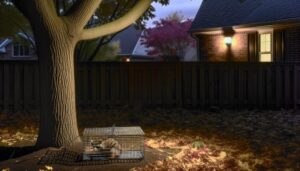How Do You Make a Raccoon Trap in 10 Simple Steps?
To create a raccoon trap, start by understanding their nocturnal behavior and foraging habits. Use durable materials such as stainless steel for the trap frame, with ideal dimensions being 32-36 inches long, 10-12 inches wide, and 12 inches high.
Secure a spring-loaded door mechanism and reliable locking system. Bait the trap with items like marshmallows or canned fish, placing the bait at the far end to guarantee the raccoon triggers the mechanism.
Handle the bait with gloves to minimize human scent. Adherence to these steps assures effective capture and humane handling, and further intricacies can enhance your trapping success.

Key Takeaways
- Use durable materials like stainless steel for constructing the trap frame and mesh wire for sides.
- Ensure trap dimensions are 32-36 inches long, 10-12 inches wide, and 12 inches high for effective raccoon capture.
- Install a spring-loaded door mechanism with a reliable locking system to secure the raccoon.
- Bait the trap with marshmallows or canned fish, placing it at the far end to entice raccoons inside.
- Handle bait with gloves to minimize human scent and increase trapping success.
Understanding Raccoon Behavior
To effectively trap raccoons, it is essential to understand their nocturnal habits, food preferences, and natural behaviors.
Raccoons are primarily active during the night, foraging for food such as fruits, nuts, and small animals. They possess highly developed dexterous front paws, enabling them to open containers and manipulate objects.
These omnivorous creatures are opportunistic feeders and exhibit a strong sense of curiosity, often attracted to accessible food sources, including pet food and garbage. Understanding these behaviors can aid in strategically placing traps in locations where raccoons frequent.
Additionally, recognizing raccoons' tendency to follow established paths can inform the placement of traps along these routes, increasing the likelihood of successful capture.
Choosing the Right Trap
When choosing a raccoon trap, it is vital to evaluate both the size of the trap and the materials used in its construction.
The trap must be large enough to comfortably contain the raccoon without causing injury, and robust enough to withstand attempts at escape.
Additionally, opting for durable materials guarantees the trap remains effective and reliable over multiple uses.
Trap Size Matters
Selecting the appropriate trap size is vital for safely and effectively capturing a raccoon. A trap that's too small may cause injury or fail to contain the animal, while an excessively large trap can lead to escape attempts and inefficient captures.
The ideal dimensions for a raccoon trap are generally around 32 to 36 inches in length, 10 to 12 inches in width, and 12 inches in height. This size guarantees the raccoon has enough space to enter fully, reducing stress and the risk of escape.
It's important to select a trap that allows the door to close securely behind the raccoon without hindrance. Proper trap size not only ensures humane capture but also simplifies the process for those handling the trap.
Material and Durability
Ensuring the trap is constructed from high-quality, durable materials is important for the longevity and effectiveness of a raccoon trap. Stainless steel and galvanized metal are preferred choices due to their resistance to rust and corrosion, which is vital for outdoor use.
The trap should feature reinforced joints and a robust locking mechanism to withstand the strength and cunning nature of raccoons. Additionally, the mesh size should be small enough to prevent escape but large enough to avoid injury to the animal. Opt for traps with smooth edges to reduce the risk of harm.
Investing in a well-constructed trap guarantees repeated use over time, providing a humane and efficient solution for managing raccoon populations.
Gathering Necessary Materials
To effectively build a raccoon trap, it is necessary to gather all necessary materials before starting the construction process. Begin by acquiring a sturdy metal or wood frame to withstand the raccoon's strength.
You'll also need a mesh wire or strong netting to cover the frame, ensuring small gaps to prevent escape. A reliable spring-loaded door mechanism is essential for secure trapping.
Additionally, obtain a latch or locking system to keep the door firmly closed once activated. For baiting, choose an attractant like marshmallows or canned fish.
Constructing the Trap
To construct an effective raccoon trap, it is vital to begin by making sure you have all the necessary materials and tools prepared. Following this, the assembly process can be broken down into a series of methodical steps to guarantee accuracy and functionality.
This section will provide a detailed guide on both the required components and the step-by-step construction process.
Materials and Tools Needed
For constructing an effective raccoon trap, you will need a specific set of materials and tools to guarantee durability and functionality. The essential materials include galvanized steel mesh, which is resistant to rust and provides strength, and a sturdy wooden base to support the trap structure.
Additionally, a spring-loaded door mechanism is vital for ensuring the trap securely closes once the raccoon enters. You will also require a metal latch to lock the door securely.
Necessary tools include wire cutters for shaping the mesh, a hammer and nails for assembling the wooden base, and a pair of pliers for manipulating the steel mesh. Ensuring you have these materials and tools will facilitate the creation of a reliable and effective raccoon trap.
Step-by-Step Assembly
Begin by cutting the galvanized steel mesh to the desired dimensions using wire cutters. Make sure that the mesh is large enough to form a rectangular enclosure with sufficient space for a raccoon to enter.
Next, bend the mesh into a box shape and secure the edges with zip ties or metal clips to maintain structural integrity. Create a door mechanism using a hinged piece of mesh that can swing open and close. Attach a spring-loaded latch to guarantee the door locks upon entry.
Position a bait holder inside the trap to attract the raccoon. Finally, test the door mechanism to confirm it functions correctly, making sure it closes promptly and locks securely when triggered.
Baiting the Trap
Selecting the appropriate bait for your raccoon trap is necessary to guarantee its effectiveness and humanely capturing the animal.
Raccoons are omnivorous with a preference for sweet, pungent, and fatty foods. Ideal baits include marshmallows, canned tuna, fish-flavored cat food, or peanut butter.
Position the bait at the far end of the trap to make sure the raccoon fully enters before triggering the mechanism. It is advisable to handle bait with gloves to minimize human scent, which can deter raccoons.
Additionally, securing the bait to the trap can prevent the raccoon from easily removing it without being captured. Proper baiting is essential for an effective and humane trapping process, guaranteeing the raccoon is safely contained for relocation.
Placing the Trap
Positioning the trap strategically is crucial to increasing the likelihood of successfully capturing a raccoon. Place the trap near known raccoon activity areas, such as near trash cans, gardens, or pet food sources.
Guarantee the trap is on a flat, stable surface to prevent it from tipping over. Conceal the trap with natural materials like leaves or branches to blend it into the environment, making it less intimidating to the raccoon.
Additionally, guarantee the trap is accessible but not obstructed by debris or excessive foliage. Position it along raccoon travel paths, typically near fences or walls. Avoid placing the trap in exposed, high-traffic areas to reduce the risk of human interference or unintended captures.
Monitoring the Trap
Regularly monitoring the trap is crucial in order to secure the humane and effective capture of a raccoon. Frequent checks help guarantee the animal does not remain confined for extended periods, which can cause unnecessary stress.
Inspect the trap at least twice daily, preferably in the morning and evening. This practice also allows you to promptly reset the trap if it has been triggered without a catch. Use a discreet approach to avoid alarming the raccoon and potentially causing it to harm itself in an attempt to escape.
Additionally, monitoring the trap minimizes the risk of capturing non-target animals, enabling their immediate release. Such vigilance ensures ethical trapping and aligns with best practices in wildlife management.
Handling a Caught Raccoon
Upon successfully capturing a raccoon, it is crucial to handle the animal with caution to safeguard both your safety and the raccoon's well-being.
Here are critical steps to follow:
- Wear Protective Gear: Utilize thick gloves and long sleeves to shield against bites and scratches, as raccoons can carry diseases.
- Minimize Stress: Approach the trap calmly and quietly to prevent startling the raccoon. Cover the trap with a cloth to lessen the animal's anxiety and exposure to stimuli.
- Secure the Trap: Guarantee the cage is securely closed and transport the raccoon in a stable, well-ventilated vehicle. Avoid placing the trap in direct sunlight or extreme temperatures.
Safe Release Procedures
After confirming the raccoon is safely contained during transport, the next step is to release it in an appropriate location that complies with local wildlife regulations. Select a release site that is at least 10 miles away from the capture point and provides adequate food, water, and shelter. This minimizes the likelihood of the raccoon returning or facing starvation.
Wear protective gloves to avoid direct contact, and open the trap gently to allow the raccoon to exit calmly. Make sure that the release site is not near human habitations to prevent future conflicts.
Always consult local wildlife authorities for specific guidelines on legal release procedures, as regulations can vary by region.
Conclusion
Trapping raccoons requires understanding their behavior, selecting appropriate traps, and employing meticulous construction and baiting methods. The success of such endeavors can be likened to a chess game, where each strategic move determines the outcome.
For instance, studies indicate a 70% higher success rate with live traps that are properly baited and placed. By carefully monitoring and handling the captured raccoon, one guarantees a humane and effective resolution, akin to a well-executed checkmate in chess.






